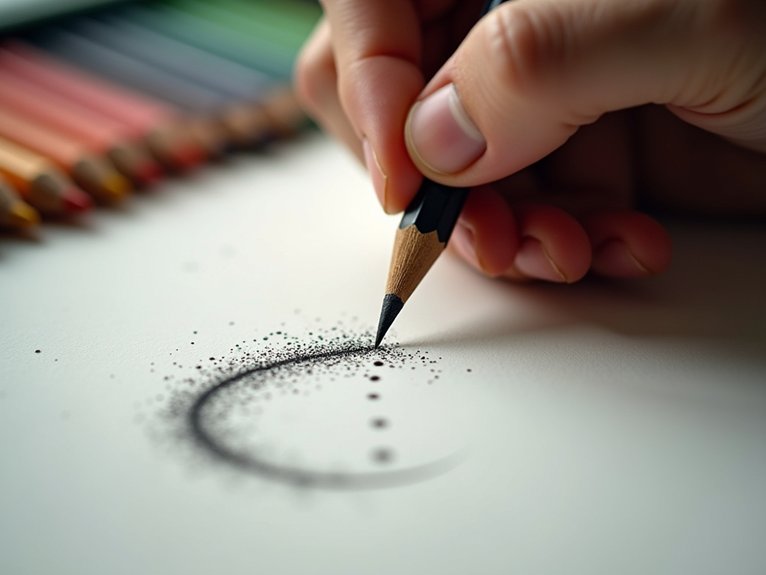Learning to draw begins with adopting a growth mindset and recognizing drawing as a learnable skill. Beginners need only basic supplies: a set of graphite pencils (2H, HB, 2B, 4B), a quality sketchbook, and an eraser. Practice basic shapes daily as fundamental building blocks for complex subjects. Focus on developing line quality and pressure control through consistent exercises. Creating a sustainable practice routine accelerates progress. The journey from novice to artist unfolds through these essential first steps.
Mindset Matters: Overcoming the „I Can’t Draw” Mentality

Many aspiring artists begin their creative journey with the self-defeating belief that drawing ability is innate rather than learned. This fixed mindset creates unnecessary barriers to artistic development and progress.
Research shows that drawing is a teachable skill that improves with deliberate practice, much like learning a musical instrument or new language. Successful artists consistently challenge their comfort zones and embrace mistakes as learning opportunities.
To overcome the „I can’t draw” mentality, beginners should reframe their thinking from talent-based to skill-based, set realistic expectations, celebrate small improvements, and focus on the process rather than perfect outcomes.
Essential Supplies for the Complete Beginner
Essential Supplies for the Complete Beginner
After establishing the right mindset, a beginner’s next step involves gathering appropriate drawing materials. Basic supplies include several pencil grades (2H, HB, 2B, 4B), a quality sketchbook with medium-weight paper, and a soft eraser. A pencil sharpener and blending stumps complete the essentials.
Beginners should avoid investing in expensive materials initially. The focus should remain on learning fundamentals rather than acquiring professional supplies. A simple set of graphite pencils offers sufficient range for practicing various techniques, from light sketching to creating deeper shadows.
These basic tools provide everything necessary for starting the drawing journey without overwhelming new artists.
Understanding Basic Shapes as Building Blocks

When artists deconstruct complex subjects into their most fundamental elements, they discover that all objects can be reduced to five basic shapes: circles, squares, rectangles, triangles, and ovals. These shapes serve as the foundation for developing drawing skills and creating complex compositions.
Beginners should practice drawing these shapes repeatedly until they become second nature. A human figure, for example, can be broken down into circles for the head and joints, rectangles for the torso, and triangles for the pelvis. By mastering these building blocks, artists learn to see subjects analytically rather than being overwhelmed by their complexity.
Mastering Line Quality and Pressure Control
While basic shapes form the foundation of drawing, the quality of lines used to create those shapes vastly impacts the final artwork. Line quality refers to the character and appearance of marks made on paper.
Artists should practice varying pressure control, creating both light, delicate lines and bold, confident strokes. This variation adds depth and dimension to drawings. Using different pressures on pencils, charcoal, or digital styluses produces lines of varying thickness and intensity.
Exercises for developing line control include contour drawing, hatching techniques, and practicing smooth shifts between thick and thin lines. Regular practice trains hand muscles to respond precisely to the artist’s intentions.
The Power of Daily Practice: Creating a Sustainable Routine

Consistent daily practice stands as the single most important factor in developing drawing skills. Artists who commit to even 15 minutes daily progress faster than those who draw sporadically for hours.
A sustainable routine involves setting realistic goals, preparing a dedicated workspace, and eliminating distractions. Many successful artists practice during the same time period each day, allowing their creativity to develop rhythmically.
Accountability tools such as progress journals, online communities, or drawing challenges provide motivation during inevitable plateaus. The compounding effect of daily practice transforms novice mark-making into confident artistic expression through gradual, persistent effort.
Seeing Like an Artist: Developing Observational Skills
Drawing effectively begins not with the hand but with the eye. Artists must train themselves to observe shapes, proportions, negative space, and light rather than symbolic representations of objects. This perceptual shift transforms drawing ability dramatically.
Beginners can develop observational skills through specific exercises:
- Contour drawing without looking at the paper
- Upside-down drawing to bypass symbolic thinking
- Negative space studies that focus on the shapes between objects
- Comparative measurement using a pencil as a measuring tool
These practices help artists see underlying structures rather than labels, enabling accurate representation of what truly exists before them.
Proportion and Perspective Fundamentals
Once an artist begins to see the world with trained eyes, mastering proportion and perspective becomes the critical next step in creating convincing drawings. Proportion refers to the relative size relationships between objects or parts of objects, while perspective creates the illusion of depth on a flat surface.
Artists should start by practicing basic measuring techniques using their pencil as a gauge. Understanding the horizon line, vanishing points, and one-point, two-point, and three-point perspective systems allows artists to accurately represent three-dimensional space. Regular practice with simple geometric forms—cubes, cylinders, and spheres—builds the foundation for tackling more complex subjects.
From 2D to 3D: Adding Depth and Shadow
The flat world of lines and shapes transforms into realistic imagery when artists apply techniques that create volume and dimensionality. Understanding the relationship between light source and object is fundamental to creating convincing depth.
Artists begin by identifying where light hits the subject, establishing highlights, midtones, and shadows. Basic shading techniques include hatching, cross-hatching, and blending. Cast shadows—those falling from objects onto surfaces—anchor drawings to their environment.
The principle of value contrast enhances three-dimensionality; greater contrast between light and dark areas creates stronger depth perception. Practicing with simple geometric forms helps develop the ability to visualize and render objects volumetrically.
Finding Your Style Through Experimentation
Finding Your Style Through Experimentation
Artistic style emerges not from imitation but through deliberate experimentation and consistent practice. Developing a unique style requires artists to explore various techniques, mediums, and approaches without fear of failure.
Artists benefit from regularly stepping outside comfort zones by attempting unfamiliar subjects or working with new materials. This exploration reveals natural preferences and strengths. Maintaining a sketchbook dedicated to experimentation creates a visual record of this journey.
While studying admired artists provides inspiration, true style development comes from synthesizing influences rather than copying them. Patience remains essential—authentic style evolves gradually through repetition, reflection, and intentional practice.
Digital vs. Traditional: Choosing Your Path
Modern artists face a pivotal decision when selecting their primary medium: digital tools or traditional materials. Each path offers distinct advantages.
Traditional media—pencils, paints, and paper—provide tactile feedback and a connection to artistic heritage. Digital platforms offer unlimited undos, diverse brushes, and streamlined workflows without supply costs.
Many successful artists blend both approaches, sketching traditionally before finishing digitally. Beginners should experiment with both to discover their preferences.
The medium ultimately matters less than consistent practice and fundamental skill development. The best choice aligns with the artist’s goals, working style, and creative vision.
Learning From Others: Community and Feedback
Learning From Others: Community and Feedback
Artists rarely evolve in isolation. Finding a creative community provides essential growth opportunities for beginning artists. Online forums, local art groups, and social media platforms offer spaces to share work and receive constructive criticism.
Feedback illuminates blind spots in technique and composition that self-assessment might miss. When seeking critique, artists should:
- Specify what feedback they need
- Remain open to suggestions
- Avoid defensive reactions
- Apply relevant advice to future work
Regular participation in community events like sketch meetups, figure drawing sessions, or art challenges accelerates skill development through shared learning experiences and accountability.
Breaking Through Plateaus and Advancing Your Skills
Every drawing journey encounters periods where progress seems to stall. These plateaus require strategic approaches to overcome. Artists should identify specific weaknesses through self-assessment and target them with focused practice exercises.
Deliberate practice—working at the edge of one’s ability—proves more effective than casual sketching. Trying new mediums, subjects, or techniques can reignite creative growth. Setting challenging but achievable goals maintains forward momentum.
Advanced artists benefit from master studies, analyzing works by established artists to understand sophisticated techniques. Regular portfolio reviews reveal long-term progress that might otherwise go unnoticed during temporary plateaus.



